Terror Nullius
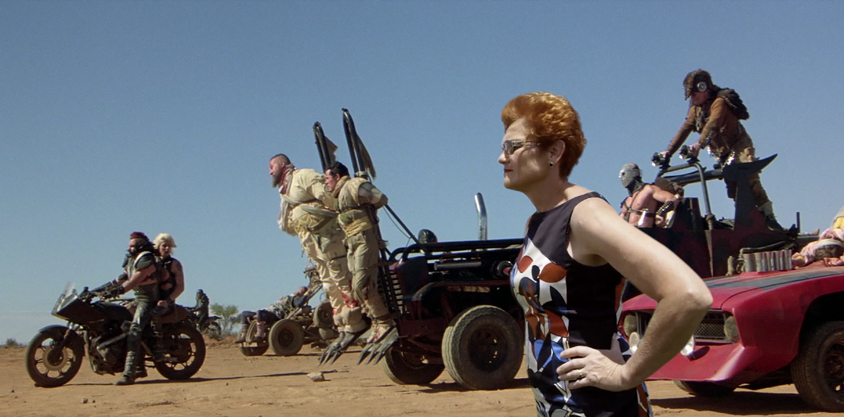
25 May, 2018
Soda_Jerk are bomb-throwers. For more than fifteen years, the Australian, New-York-based collaborative unit have made an art practice out of cutting, collaging and appropriating—watching for the blind spots in the official narratives of culture, politics and history, fascinated less by what’s present than what’s omitted. Now, in their 55-minute video work, Terror Nullius (2018), they remix, rewrite and revise the history of Australian film, overlapping and converging familiar screen icons in a new anti-racist, queer, feminist grand narrative.
Terror Nullius is an anthemic work hatched from remix culture, with copyrighted samples taken without permission from canonical film and television. As in much of Soda_Jerk’s previous work, the construction of a new narrative happens in post-production, with masterful editing that’s seamless and sensitive to rhythm. This is video made without sets or actors— rather, it hauls the sediment of cinema history back to the surface. To montage, Soda_Jerk add in frame-collage, inserting people and objects into the frames of other films. Russell Crowe’s neo-Nazi from Romper Stomper (1993) is embedded into a Cronulla-style race riot on a beach, before being killed by a vindictive gull. Tom Burlinson from The Man From Snowy River (1982) valiantly glides through a forest, nodding and smiling in queer solidarity with a group of men having sex with one another (excised from the 2013 French murder mystery, Stranger by the Lake). Skippy and Sonny look down on Hanging Rock, where Miranda and her schoolgirl friends are being slayed by Mick Taylor (John Jarratt) of Wolf Creek (2005).
The form fits the intention: to ‘un-write’ the country’s mythology, to subvert the original conservative message of much local storytelling, to render Australia uncanny and silly, and to rip apart and then reassemble the nation’s stories from the red dusty ground up.
As an audiovisual collage, it is structured to make certain conventions visible again: those of the road film, the outback horror film, the post-apocalyptic action film, and the very similar ways in which the desert and the bush have been visualised on screen. Familiar themes recur: there’s the revenge of nature, and the presentation of the outback and bush as Gothic landscapes of malevolence.
It goes without saying then, that Terror Nullius is a dense text, largely sidelining urban settings for a focus on an Australian imaginary that can be found in the continent’s centre. Many have traced Soda_Jerk’s approach to electronic music sampling, but I think Adrian Martin is correct when he says that montage is their premier arsenal. It is, after all, cinema’s basic language. Taking contrasting elements, colliding them, bursting them open, and making something bigger than the sum of the parts, is what montage does.
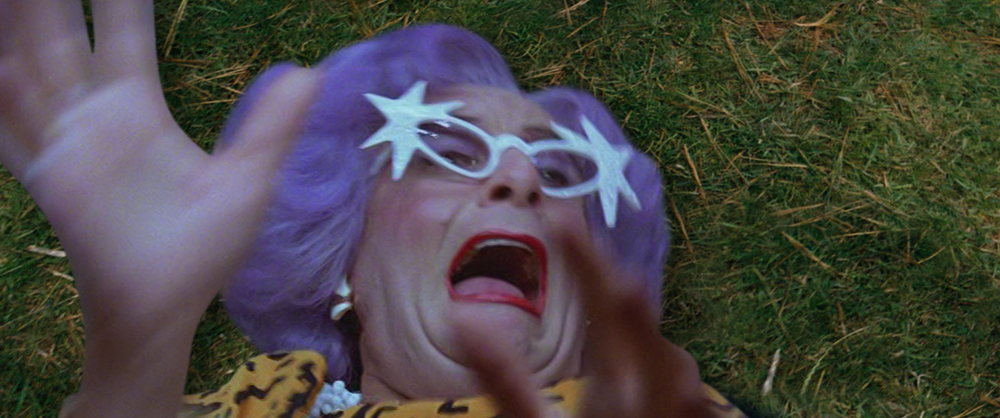
Soda_Jerk, Terror Nullius (2018)
video, 55 min, courtesy the artists
and Sydney Film Festival
For me, the metaphorical, associative power of Soda_Jerk’s art of montage resonates most in Dark Matter, a series of works I will never forget. In After the Rainbow (2009), the second of the series, Dorothy wanders about her desolate Kansas home. Peering through one of the doorways, she sees Judy Garland, 45 years older and immeasurably sadder, singing of bitter nights and wasted dreams in ‘The Man That Got Away.’ Jittery with tears, Dorothy approaches her older self, and Judy’s tragic star persona and her onscreen character melt together in anticipated regret. In drawing on what we know of popular culture, and thinking through existing images in new and emotionally resonant ways, the work is a testament to Soda_Jerk’s dramatic skills. This is a rarity in video art, which often intentionally demotes the dramaturgy and narrative impetus of cinema. When I think of that moment, still, I think of David Lynch’s idea that ‘sometimes, in a frame, if there’s some question about what you’re seeing, or some dark corner, the mind can go dreaming.’ He’s talking about that space of freedom in your mind where the artwork grows and evolves in tune with the associations you bring to it.
Likewise, Tramp the Dirt Down, a 2017 video by Conor Bateman, works by subtly triggering the viewer’s own creative thinking, whilst also covering some of Terror Nullius’ conceptual terrain about the bullshit nature of Australian nationhood. (Full disclosure: I commissioned this work, originally as a video essay, last year at RealTime arts magazine.) Like many fine artworks, Tramp the Dirt Down sets its conceptual parameters tight with a few basic rules: first, Bateman chooses clips of white people in Australian films shooting guns; second, through editing, they are made to shoot at the silent landscape; and third, the landscape eventually responds. The video is fired with intelligence, and its rage tempered with contemplative and conceptual consideration.
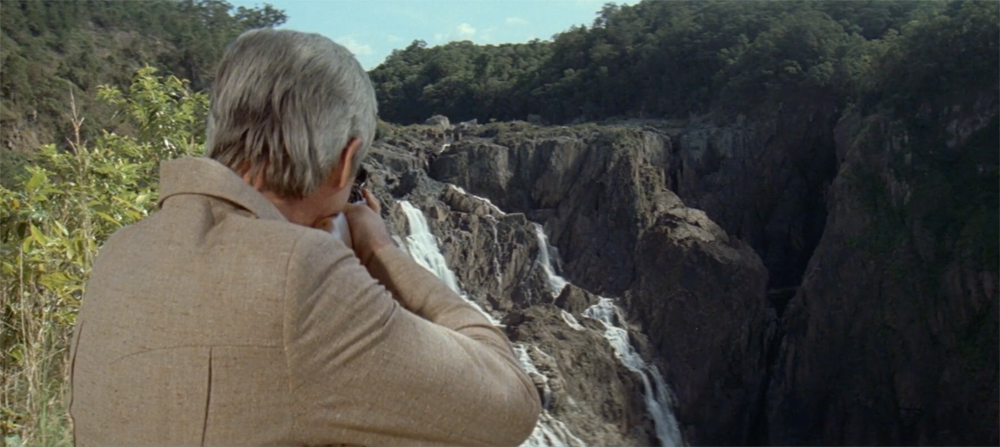
Conor Bateman, Tramp the dirt down (2017), video, 5min 50sec
commissioned by RealTime
Terror Nullius throws these kinds of tight conceptual parameters away, opening its jaws wide and consuming everything in sight. Its polemic traverses heteronormativity, toxic masculinity, fed-up women, white settlers, resource-rich capitalists. All these themes are connected in some way, of course, but the nature of the connection isn’t made explicit (except for their life underneath the banner of ‘Australia’). Australia: myth, lie, federated convict prison, seventh continent, parochial island, mining paradise with patrolled borders and offshore detention camps, and, more recently, a bullshit Eden of negatively-geared baby boomers and indebted millenial renters.
Like Soda_Jerk’s previous work, Terror Nullius reveals some biases of the cultural canon, such as the toxic blokey nonsense of Steve Irwin and Paul Hogan and The Man from Snowy River. But it also risks overlooking the digressions already made from the status quo. That is to say that, as Radio National’s Jason Di Rosso has argued, Terra Nullius skates over the stream of screen culture that has already critiqued white Australia, refugee policy and Indigenous genocide, even as it draws on it for source material. Sometimes it reverts to Australian films’ overworked tropes, such as the revenge of nature (which I have critiqued elsewhere), as evidenced in a scene where maniacal sheep attack a rural Bicentenary celebration.
One scene places a tape of Mel Gibson abusing his IRL wife in the hands of Charlize Theron’s Furiosa in Mad Max: Fury Road (2015). She gathers her feminist gang, including a young Nicole Kidman in BMX Bandits (1983), and wages vindictive war on young Max Rockatansky (played by Gibson in the first three installments) and his car. The scene is clever for the way it brings old Mel and young Max into the one misogynist onscreen figure. But Fury Road already holds strong feminist as well as ecological themes, so the repurposed scene has less to do: it subverts the real-life figure of Gibson, but not the Mad Max films themselves (1979-85). This is even more apparent given that the Mad Max stories have always thematically reflected on white people’s sense of discomfort about their place in Australia outside the cities, with the symbolic safety of the car, and the road as ‘civilisation’, visualising this anxiety.
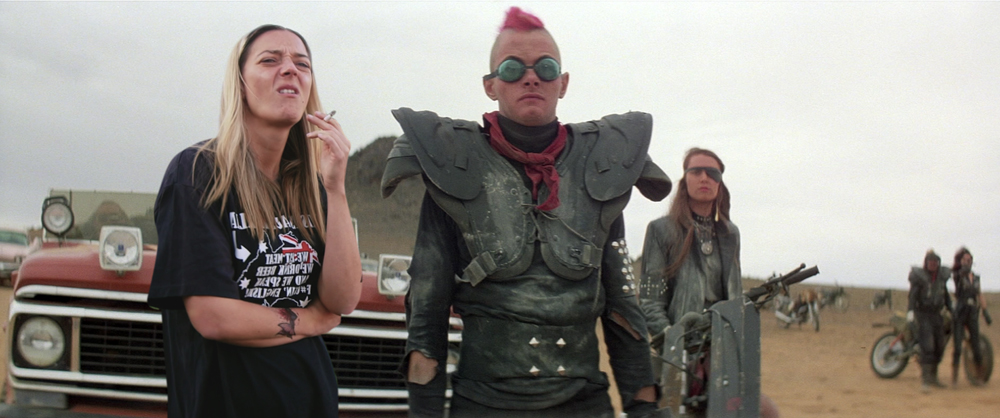
Soda_Jerk, Terror Nullius (2018)
video, 55 min, courtesy the artists
and Sydney Film Festival
As Australian film scholar Ben Wilkie wrote upon Fury Road’s release, ‘though the colonial origins of this discomfort are muted, Mad Max’s position within the Australian gothic tradition is undeniable. The original Mad Max films appeared at a time when Australia filmmakers were beginning to explore the deeper, more uncomfortable consequences of attempting to forge a sense of national identity in a former British colony.’ In Terror Nullius, a clip from Crocodile Dundee (1986) perfectly articulates the idea that Mad Max critiques. Sue, an American journalist, says to Paul Hogan’s iconic character, ‘Despite the rugged beauty of this land, there’s a sort of strange emptiness to it.’ Films like Crocodile Dundee invest in the lie of Australia as dead-hearted, while the Mad Max stories have revealed that lie over the course of decades. In its use of postcolonial texts to critique postcolonial texts, the source material in Terror Nullius is less powerful than it initially seems, in that many of the films are not in fact being subverted against their original aims. This can also be considered an interdisciplinary question—crossing the boundaries (and systems of knowledge) between cinema and art is a difficult task, and artist’s films and feature-length videos are rare forms in Australia.
The Mad Max films aren’t the only significant Australian texts that have in some way criticised or considered colonialism and deep racism, and such films include many harvested by Soda_Jerk: Romper Stomper (1992), Wake in Fright (1971), Walkabout (1971), The Cars That Ate Paris (1974), The Piano (1993), Ten Canoes (2006), Strangerland (2015), Spear (2015) and Goldstone (2016). Many of these films are not really part of the ‘official archive’, but a resistive archive that reflects on Australia’s fraught sense of its own foundations. And yet Terror Nullius treats these texts in equivalence with Kath and Kim (2002-05), as well as generic films like Black Water (2007) and Wolf Creek that thoughtlessly exploit the idea of a malevolent Australian environment. The history of film and television, and their messages, diverge much more than is apparent in Terror Nullius, which also precludes some of Australian screen culture’s whitest, most proudly denialist products like Home and Away and Sunrise.
The real question is why did the colonial critique advanced by filmmakers in the New Wave in the 1970s fade away? Why is it now mainly Indigenous filmmakers who are grappling with colonialism, when it is really the essential question for all? And why hasn’t Australian television ever sustained a deep critique of dispossession and whiteness?
The most resonant moments of Terror Nullius meaningfully deepen the sentiment of already existing intelligent cinema by bonding the polemic with the poetic. At the work’s apex, Anthony LaPaglia, a disconnected husband and detective in Lantana (2001), breaks down in his car listening to John Pilger polemicising how ‘Britain waged war, carried out in the name of God, king, anthropology, money and land’, bringing a well of emotional profundity to the film. A feral orphan from Mad Max 2 (1981) approaches an encampment that has been repurposed as Woomera Detention Centre. Many clips from Lucky Miles, a little-seen 2007 drama about refugees, make its protagonists’ fights with conservatives and neo-fascists more literal. In these moments, Terror Nullius thinks through cinematic processes we generally take for granted, and reminds us that there is something acutely wrong about the way Australia remembers its past.
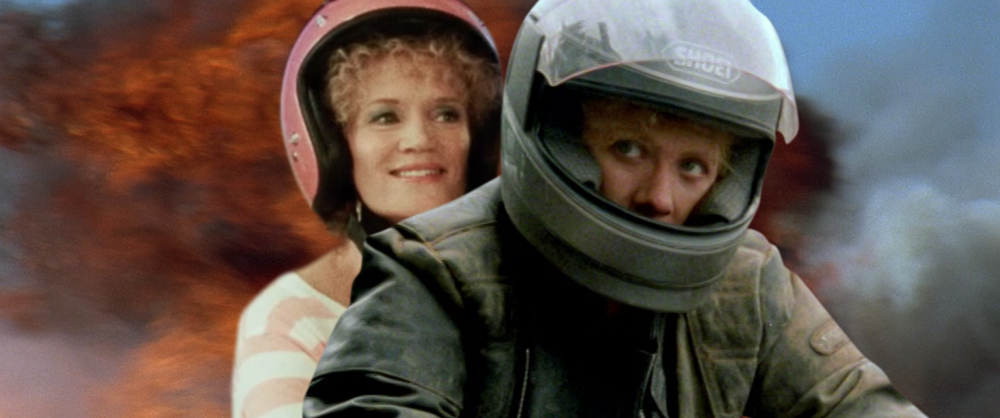
Soda_Jerk, Terror Nullius (2018)
video, 55 min, courtesy the artists
and Sydney Film Festival
Much of the commentary so far has centred on Terror Nullius’ notoriety as a ‘controversial Australiana art film’ following the Ian Potter Foundation’s clumsy, conservative tantrum in withdrawing their name and support. It’s a shame that the most regressive voices—belonging to those who believe that an irreverent vision of Tony Abbott and Pauline Hanson being decapitated by a boomerang by Mad Max maniacs is reprehensible—have jumpstarted the critical response to this artwork. Because in some strange but important way, Terror Nullius lovingly celebrates the innate weirdness of this country’s national cinema. As a revisionist work, it chimes with so many people’s progressive desire for change against the free fall of global politics and the stasis of #auspol. Where many contemporary artworks can feel dry and theory-driven, Terror Nullius is alert to the present moment’s feeling of creeping dissatisfaction. It has an Australian energy harnessed for real subversion—not the larrikin type (another Australian mythical creation), but the political maverick. It reminds the frustrated and the forgotten that Australia isn’t just stuffed with people in sales and marketing, chasing the real estate dream—and that the cinema isn’t just full of Red Dogs (2011).